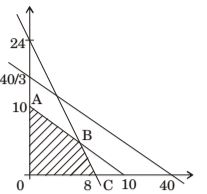Industrial Engineering Miscellaneous
- The sale of cycles in a shop in four consecutive months are given as 70, 68, 82, 95. Exponentially smoothing average method with a smoothing factor of 0.4 is used in forecasting. The expected number of sales in the next month is
-
View Hint View Answer Discuss in Forum
Ft+1 = Dt + α(1 – α) Dt–1 + α(1 – α) ² Dt–2
Ft+1 = 0.4 (95) + 0.4 (1 – 0.4)² + α(1 – α)³ Dt–3 + (0.4) (1 – 0.4)² × 68 + (0.4) (1 – 0.4)³ × 70
Ft–1 = 73.52 unitsCorrect Option: C
Ft+1 = Dt + α(1 – α) Dt–1 + α(1 – α) ² Dt–2
Ft+1 = 0.4 (95) + 0.4 (1 – 0.4)² + α(1 – α)³ Dt–3 + (0.4) (1 – 0.4)² × 68 + (0.4) (1 – 0.4)³ × 70
Ft–1 = 73.52 units
- A regression model is used to express a variable V as a function of another variable X, this implies that
-
View Hint View Answer Discuss in Forum
NA
Correct Option: A
NA
- In an assembly line for assembling toys, five workers are assigned tasks which take times of 10, 8, 6, 9 and 10 minutes respectively. The balance delay for line is
-
View Hint View Answer Discuss in Forum
Assuming cycle time = 10 + 8 + 6 + 9 + 10 = 43
Balance delay = 1 - ∑ ti = 1- 43 = 0.14 n × te 5 × 10
= 14%Correct Option: C
Assuming cycle time = 10 + 8 + 6 + 9 + 10 = 43
Balance delay = 1 - ∑ ti = 1- 43 = 0.14 n × te 5 × 10
= 14%
- If at the optimum in a linear programming problem, a dual variable corresponding to a particular primal constraint is zero, then it means that
-
View Hint View Answer Discuss in Forum
NA
Correct Option: C
NA
- A manufacturer produces two types of products, 1 and 2, at production levels of x1 and x2 respectively. The profit is given is 2x1 + 5x2. The production constraints are :
x1 + 3x2 < 40
3x1 + x2 < 24
x1 + x2 < 10
x1 > 0 , x2 > 0
The maximum profit which can meet the constraints is
-
View Hint View Answer Discuss in Forum

Feasible Region (0– A – B – C– 0)
At point (A) 0, 10)
Z = 2 (0) + 5 (10) = 50
At point B (7,3)
Z = 2(7) + 5(3) = 2y
At point C (8, 0)
Z = 2(16) + 5(0) = (16) 2
⇒ 32
Hence maximum profit is Zmax = 50
No correct option is given.Correct Option: C

Feasible Region (0– A – B – C– 0)
At point (A) 0, 10)
Z = 2 (0) + 5 (10) = 50
At point B (7,3)
Z = 2(7) + 5(3) = 2y
At point C (8, 0)
Z = 2(16) + 5(0) = (16) 2
⇒ 32
Hence maximum profit is Zmax = 50
No correct option is given.

